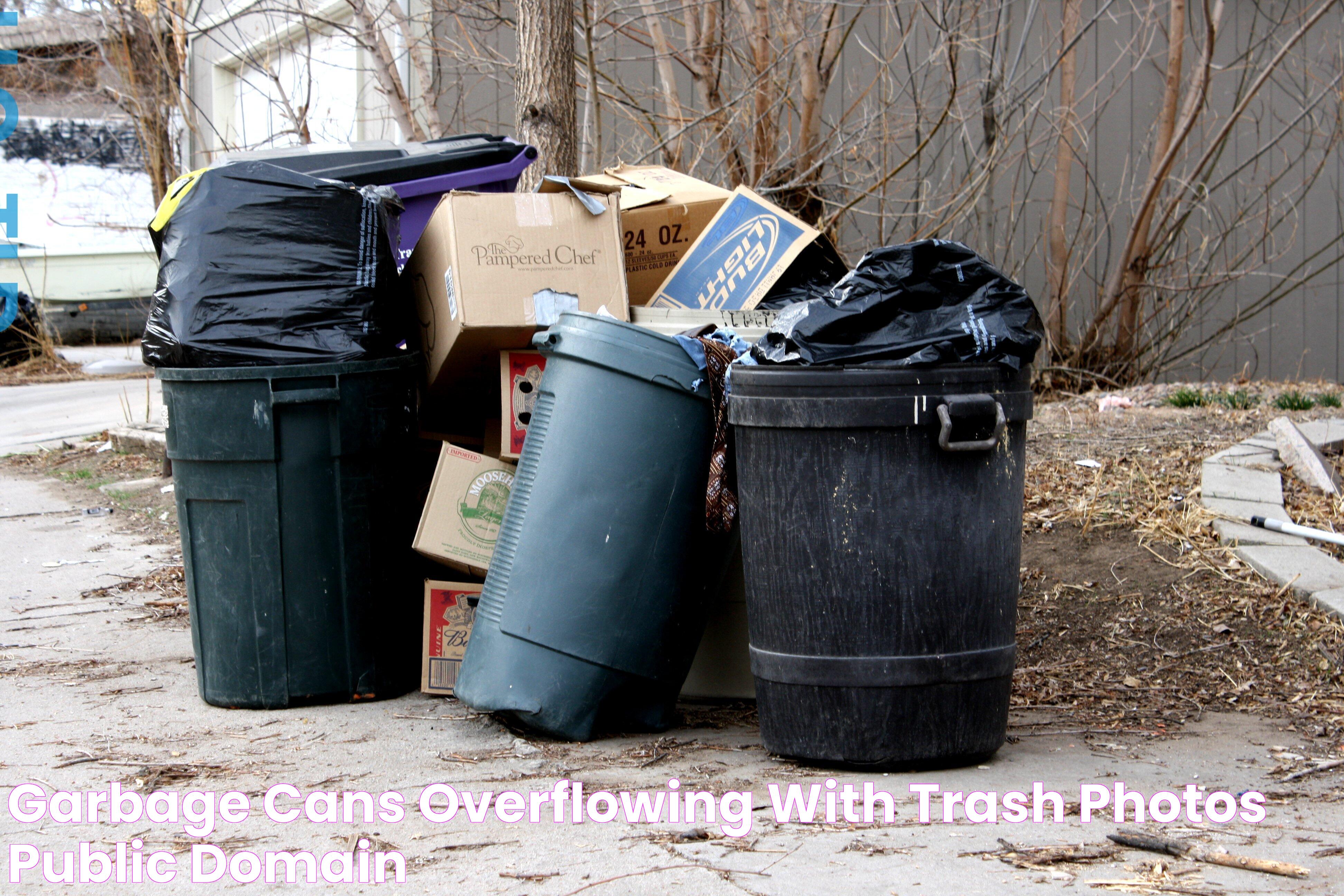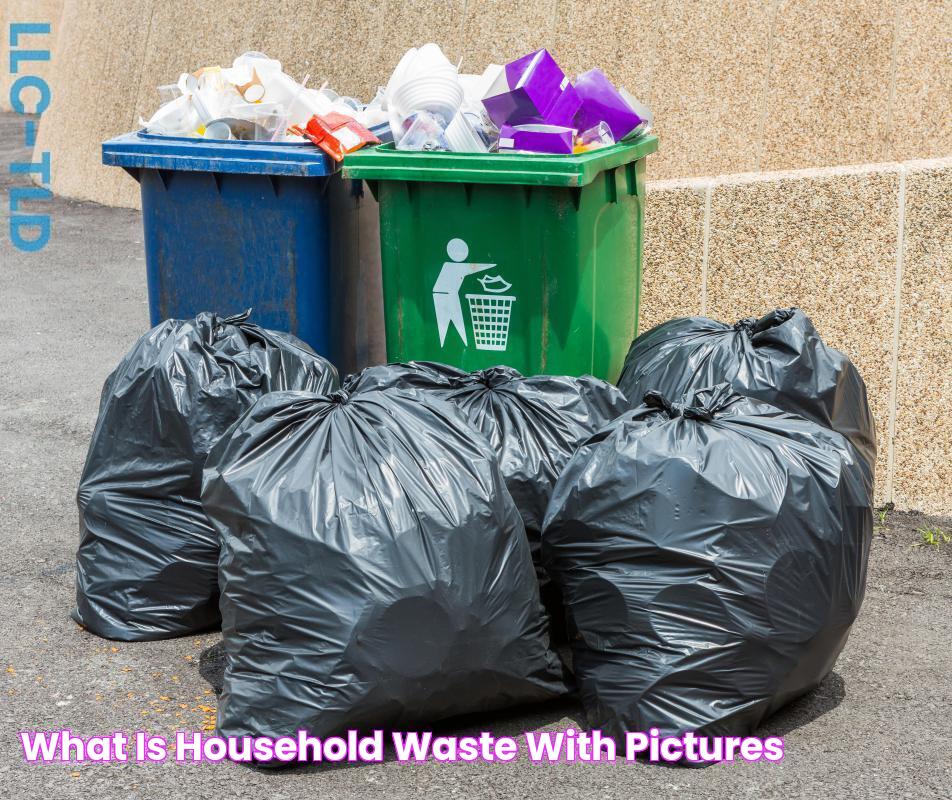The Ultimate Guide To Garbage Disposal: Tips For Efficient Waste Management
Garbage refers to any discarded solid waste material. It encompasses a wide range of items, including food scraps, paper, plastic, metal, and electronic waste. Garbage is a byproduct of human activities and can accumulate in various forms, such as household waste, commercial waste, and industrial waste.
Garbage plays a pivotal role in the functioning of our societies. It serves as a source of valuable resources that can be recovered and reused through recycling and composting processes. Additionally, proper garbage disposal is crucial for maintaining public health and preventing environmental pollution. Historically, garbage management practices have evolved from simple dumping to sophisticated waste management systems that involve waste reduction, reuse, recycling, and responsible disposal.
This article delves deeper into the topic of garbage, exploring its environmental impact, the challenges associated with waste management, and the innovative solutions being developed to address these issues. It also examines the role of individuals and communities in promoting sustainable waste management practices and reducing the environmental footprint of garbage.
Read also:The Extraordinary Net Worth Of Kendra G Exploring Her Financial Success
Garbage
Garbage, encompassing various solid waste materials, constitutes a significant aspect of our environment and daily lives. Understanding its key facets is crucial for effective waste management and environmental sustainability.
- Waste: Garbage is a byproduct of human activities, discarded as unwanted or unusable material.
- Pollution: Improper garbage disposal can lead to environmental pollution, contaminating air, water, and soil.
- Health: Garbage accumulation can pose health risks, providing breeding grounds for pests and pathogens.
- Resources: Garbage contains valuable resources that can be recovered and reused through recycling and composting.
- Management: Effective garbage management systems involve waste reduction, recycling, and responsible disposal.
- Sustainability: Promoting sustainable waste management practices helps reduce garbage's environmental impact.
- Responsibility: Individuals and communities play a crucial role in responsible garbage disposal and waste reduction.
- Innovation: Technological advancements and innovative solutions are constantly being developed to address garbage-related challenges.
These key aspects highlight the multifaceted nature of garbage, its impact on the environment and human health, and the importance of sustainable waste management practices. By understanding and addressing these aspects, we can work towards reducing garbage's negative effects and promoting a cleaner, healthier planet.
1. Waste
Waste, in the context of garbage, refers to the discarded and unwanted materials generated as a result of human activities. Understanding the nature of waste is crucial for developing effective waste management strategies and reducing the environmental impact of garbage.
- Types of Waste
Garbage encompasses a wide range of waste materials, including household waste, commercial waste, and industrial waste. Each type of waste has unique characteristics and poses specific challenges for waste management.
- Sources of Waste
Waste is generated from various sources, including residential, commercial, and industrial activities. Identifying the sources of waste helps in developing targeted waste reduction and management programs.
- Waste Reduction
Reducing waste at the source is a critical aspect of waste management. Implementing waste reduction strategies, such as reducing packaging, composting organic waste, and promoting reuse, can significantly decrease the amount of garbage generated.
Read also:
- Crystal Renee Haysletts Age A Detailed Look
- Waste Disposal
Proper waste disposal is essential for protecting the environment and public health. Waste disposal methods include landfilling, incineration, and recycling, each with its own advantages and disadvantages.
By understanding the nature of waste and implementing comprehensive waste management strategies, we can effectively reduce the environmental impact of garbage and promote a more sustainable and healthier planet.
2. Pollution
Improper garbage disposal poses a significant threat to the environment, leading to various forms of pollution that can harm human health and ecosystems. Understanding the connection between garbage and pollution is crucial for developing effective waste management strategies and promoting environmental sustainability.
When garbage is not disposed of properly, it can accumulate in landfills, dumpsites, and natural environments, releasing harmful pollutants into the air, water, and soil. For example, decomposing organic waste in landfills generates methane, a potent greenhouse gas that contributes to climate change. Improper disposal of hazardous waste, such as batteries and electronic waste, can leach toxic chemicals into the soil and groundwater, contaminating drinking water sources and harming aquatic life.
Addressing the issue of garbage pollution requires a multi-pronged approach. Reducing waste generation, promoting recycling and composting, and implementing proper waste disposal systems are essential steps towards mitigating the environmental impact of garbage. By understanding the connection between garbage and pollution, we can work towards creating a cleaner, healthier, and more sustainable planet.
3. Health
Garbage accumulation poses significant health risks to humans and the environment. Understanding the connection between garbage and health is crucial for promoting public health and developing effective waste management strategies.
- Pest Infestation
Accumulated garbage provides an ideal breeding ground for pests, such as rodents, cockroaches, and flies. These pests can carry and transmit various diseases, including food poisoning, dysentery, and typhoid fever. Infestations can also lead to allergies, respiratory problems, and psychological distress.
- Pathogen Growth
Garbage provides nutrients for the growth and multiplication of pathogens, including bacteria, viruses, and fungi. These pathogens can cause a range of infections and diseases, from mild skin irritations to life-threatening illnesses. Improper disposal of medical waste can further contribute to the spread of pathogens.
- Air and Water Pollution
Decomposing garbage releases harmful gases and pollutants into the air and water. These pollutants can cause respiratory problems, cardiovascular diseases, and other health issues. Leachate from landfills and dumpsites can contaminate groundwater and surface water, posing risks to aquatic life and human health.
- Environmental Justice
Garbage accumulation often disproportionately impacts low-income and marginalized communities. These communities may have limited access to proper waste disposal services, resulting in increased exposure to health risks associated with garbage.
Addressing the health risks associated with garbage requires a comprehensive approach that includes waste reduction, proper waste disposal, and public health education. By understanding the connection between garbage and health, we can work towards creating a cleaner, healthier, and more sustainable environment for all.
4. Resources
Garbage is not merely waste; it contains valuable resources that can be recovered and reused through recycling and composting. This process not only reduces the amount of garbage sent to landfills but also conserves natural resources and promotes sustainability.
- Metals
Garbage contains significant amounts of metals, such as aluminum, steel, and copper. Recycling these metals saves energy and reduces the need for mining and extraction, conserving natural resources and minimizing environmental impacts.
- Paper and Cardboard
Paper and cardboard are major components of garbage, and recycling them helps preserve forests and reduce greenhouse gas emissions associated with paper production. Recycled paper and cardboard can be used to create new products, reducing the demand for virgin materials.
- Plastics
While some plastics are recyclable, many end up in landfills or as litter. Recycling plastics helps reduce plastic pollution and conserves fossil fuels used in plastic production. Advanced recycling technologies are being developed to address the challenges of recycling certain types of plastics.
- Organics
Organic waste, such as food scraps and yard waste, can be composted to create nutrient-rich soil amendments. Composting reduces the amount of organic waste sent to landfills, where it decomposes and generates methane, a potent greenhouse gas.
By harnessing the resources found in garbage through recycling and composting, we can create a more circular economy, reduce our environmental footprint, and promote a more sustainable future.
5. Management
Effective garbage management is crucial for mitigating the environmental and health impacts of garbage. It involves waste reduction, recycling, and responsible disposal, each playing a vital role in minimizing the amount of garbage sent to landfills and promoting a circular economy.
Waste reduction initiatives, such as composting organic waste and reducing packaging, help decrease the amount of garbage generated at the source. Recycling involves collecting and processing recyclable materials, such as paper, plastic, and metal, to create new products. Responsible disposal methods, like landfilling and incineration, must adhere to environmental regulations to minimize pollution and protect public health.
Understanding the connection between effective garbage management and garbage is essential for several reasons. Firstly, it highlights the importance of waste reduction and recycling in reducing the amount of garbage produced. Secondly, it emphasizes the need for proper disposal methods to prevent environmental and health hazards associated with garbage accumulation. Thirdly, it showcases the potential of garbage as a valuable resource that can be recovered and reused through recycling and composting.
6. Sustainability
The connection between sustainability and garbage is crucial for understanding the environmental impact of waste management practices. Sustainable waste management practices prioritize the reduction of garbage and its negative environmental consequences. By promoting waste reduction, recycling, and responsible disposal, we can significantly diminish the amount of garbage that ends up in landfills and the environment.
Reducing garbage through sustainable practices is essential for mitigating its environmental impact. Landfills, a common destination for garbage, contribute to greenhouse gas emissions, pollute groundwater, and attract pests. Recycling, on the other hand, conserves natural resources, reduces energy consumption, and lowers greenhouse gas emissions associated with extracting and processing raw materials.
Sustainable waste management practices are not only beneficial for the environment but also for the economy. Recycling and composting create jobs, reduce the need for raw material extraction, and support the development of a circular economy. By understanding the connection between sustainability and garbage, we can implement effective waste management strategies that minimize environmental degradation and promote a more sustainable future.
7. Responsibility
The connection between "Responsibility: Individuals and communities play a crucial role in responsible garbage disposal and waste reduction" and "garbage" is significant because it highlights the importance of individual and collective action in addressing the issue of garbage and its environmental impact.
Individuals have a responsibility to dispose of their garbage properly, reducing waste, and recycling whenever possible. Responsible garbage disposal involves separating recyclable materials, such as paper, plastic, and metal, from non-recyclable waste and discarding them in designated bins or recycling centers. By doing so, individuals contribute to reducing the amount of garbage that ends up in landfills and promotes the recovery of valuable resources.
Communities play an equally crucial role in waste reduction and responsible garbage disposal. Community-led initiatives, such as recycling programs, composting schemes, and waste reduction campaigns, can significantly impact garbage management. These initiatives not only educate individuals about responsible waste disposal practices but also provide the infrastructure and support necessary to make it easier for community members to reduce their garbage footprint.
Understanding the connection between responsibility and garbage is essential for promoting sustainable waste management practices. By recognizing the role individuals and communities play in reducing garbage and its environmental impact, we can collectively work towards a cleaner and healthier planet.
8. Innovation
As the world grapples with the ever-increasing problem of garbage, innovation has emerged as a beacon of hope. Technological advancements and creative solutions are being developed to tackle garbage-related challenges, ranging from waste reduction to recycling and disposal.
- Waste Reduction Technologies
Innovative technologies are being developed to reduce the amount of waste generated at the source. These include smart bins that monitor fill levels and optimize waste collection, as well as devices that convert organic waste into compost or biogas.
- Advanced Recycling Techniques
New recycling technologies are emerging to improve the efficiency and effectiveness of recycling processes. These include optical sorters that can identify and separate different types of recyclable materials, as well as chemical recycling methods that can break down non-recyclable plastics into reusable materials.
- Sustainable Disposal Solutions
Innovative approaches to garbage disposal are being explored to minimize environmental impact. These include plasma gasification systems that convert waste into a synthetic gas, as well as anaerobic digestion technologies that produce biogas from organic waste.
- Waste-to-Energy Technologies
Technologies are being developed to harness the energy potential of garbage. These include waste-to-energy plants that generate electricity from the combustion of waste, as well as biofuel production facilities that convert organic waste into renewable fuels.
These innovative solutions, while still in various stages of development and implementation, hold immense promise for addressing garbage-related challenges. By embracing innovation and investing in research and development, we can pave the way for a more sustainable and waste-conscious future.
Frequently Asked Questions about Garbage
This section addresses some common questions and misconceptions regarding garbage and its impact on our environment.
Question 1: What is the difference between garbage and waste?
Answer: Garbage refers to discarded solid waste materials, typically generated from households, businesses, and industries. Waste is a broader term that encompasses all discarded materials, including liquids and gases.
Question 2: Why is garbage a problem?
Answer: Improperly managed garbage poses significant environmental and health risks. It can contaminate air, water, and soil, providing breeding grounds for pests and pathogens.
Question 3: How can we reduce the amount of garbage we produce?
Answer: Waste reduction strategies include reducing packaging, composting organic waste, and choosing reusable products over single-use items.
Question 4: What is recycling, and why is it important?
Answer: Recycling involves processing and transforming waste materials into new products. It helps conserve natural resources, reduce pollution, and save energy.
Question 5: How is garbage disposed of?
Answer: Common garbage disposal methods include landfilling, incineration, and composting. Each method has its own advantages and drawbacks, and the choice depends on factors such as waste composition and environmental regulations.
Question 6: What are the innovative solutions being developed to address garbage-related challenges?
Answer: Technological advancements are leading to new waste reduction techniques, advanced recycling methods, and sustainable disposal solutions, paving the way for a more waste-conscious future.
Understanding these key aspects of garbage is crucial for promoting responsible waste management practices and reducing its negative environmental impact.
Transition to the next article section: Exploring the Future of Garbage Management
Tips for Effective Garbage Management
Implementing effective garbage management practices is essential for preserving our environment and protecting public health. Here are several tips to help you reduce, reuse, and responsibly dispose of garbage:
Tip 1: Reduce Waste Generation
Start by reducing the amount of garbage you produce. Use reusable shopping bags, opt for products with less packaging, and compost organic waste.
Tip 2: Segregate and Recycle
Separate recyclable materials, such as paper, plastic, and metal, from your regular garbage. Recycling helps conserve natural resources and reduces the amount of waste sent to landfills.
Tip 3: Practice Composting
Composting organic waste, such as food scraps and yard trimmings, creates a nutrient-rich soil amendment while reducing methane emissions from landfills.
Tip 4: Choose Reusable Products
Whenever possible, opt for reusable products over single-use items. This includes using reusable water bottles, coffee mugs, and shopping bags.
Tip 5: Support Sustainable Businesses
Support businesses that prioritize waste reduction and sustainable practices. This encourages businesses to adopt more environmentally friendly operations.
Tip 6: Educate Yourself and Others
Stay informed about garbage management best practices and share your knowledge with others. Educate your family, friends, and community about the importance of waste reduction and proper disposal.
Tip 7: Advocate for Policy Changes
Support policies that promote waste reduction, recycling, and composting. Encourage your local government to implement comprehensive waste management programs.
By following these tips, you can contribute to a more sustainable and garbage-conscious society. Remember, every effort, no matter how small, makes a difference in reducing the environmental impact of garbage.
Transition to the article's conclusion: The Importance of Collective Responsibility in Garbage Management
Conclusion
Throughout this article, we have explored the multifaceted nature of garbage, shedding light on its environmental, health, and societal impacts. We have discussed the importance of waste reduction, recycling, composting, and responsible disposal practices.
Addressing the issue of garbage requires a collective effort from individuals, communities, and governments. By embracing sustainable waste management practices and advocating for change, we can create a cleaner, healthier, and more sustainable planet for present and future generations.
Discover Alex's Secret: The Ultimate Guide To Uncovering Hidden Truths
FBI's Most Wanted List 2025: Track Down The Nation's Most Notorious Criminals
Unveiling The Harrowing Story Of Lisa McVey: A Triumph Over Darkness


